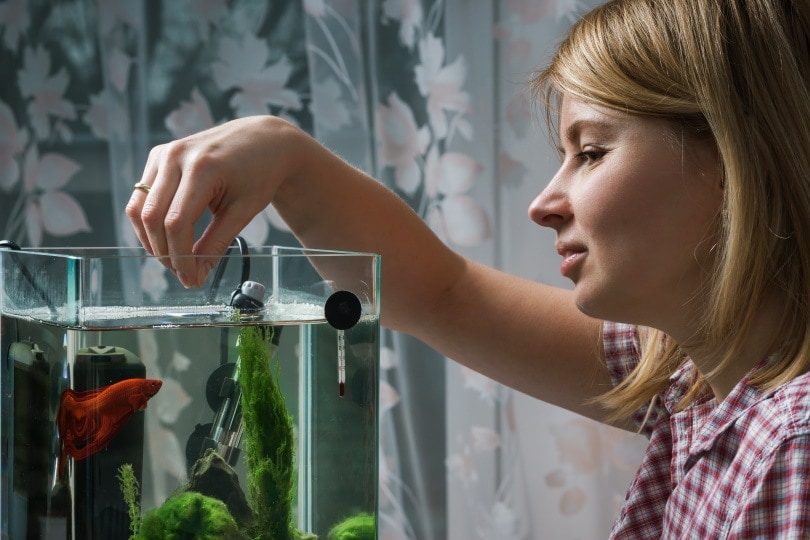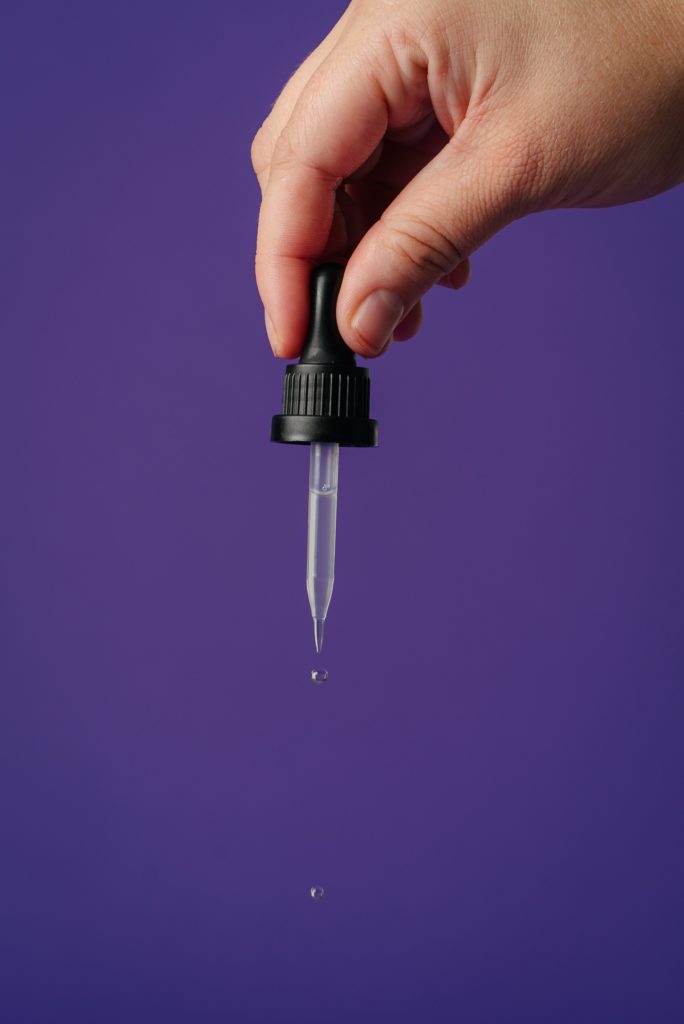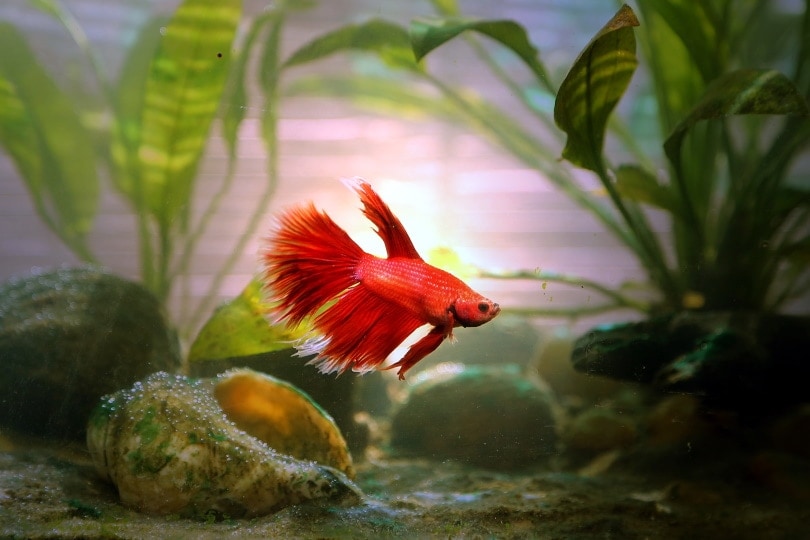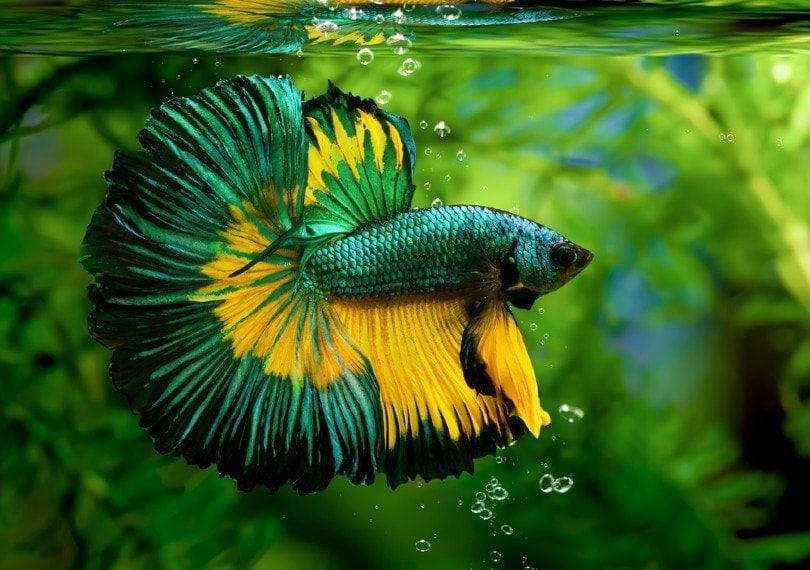Do Betta Fins Grow Back? Vet-Approved Causes, Care & Prevention Tips

Updated on

Click to Skip Ahead
The Betta or Siamese fighting fish is a popular aquarium species. These small-sized fish are known for their vibrant colors and long fins. Before adding this species to your aquarium, keep in mind that their fins are vulnerable to damage.
Your betta can grow back the damaged fins in ideal conditions, but this can also result in complications. In some instances, the new fins may not resemble the original fins in color, size, and shape. Several factors cause fin loss. Therefore, before you keep Bettas, you need to learn how to identify the signs of fin damage and what’s causing it before embarking on any form of treatment.
Let’s examine what causes fin damage and how to grow them back.
What Causes Fin Loss in Betta Fish?
Betta fins and tails are very fragile. Because of this, the tissue is highly prone to tears and injury when the fish is swimming in the fish tank. You should be concerned once you start noticing that your fish has repeated tears on their fins.
Here are some of the reasons why this occurs.

Fin Rot
This is the most common reason for fin loss in Betta fish. Fin rot is a infection that affects aquarium fish by slowly disintegrating away the fins.
This disease occurs together with other infections and results from placing your fish in a dirty tank or exposing your fish to infectious substances (such as harmful bacteria). It can also be caused by a fungal agent at times. At other times, a bacterial and fungal infection occur simultaneously. Once your Betta gets this infection, it manifests itself as torn or ragged fins that may eventually fall off.
Apart from the circulation in the fish tank, fin rot is also exacerbated by ammonia or nitrite poisoning. The ammonia burns your Betta’s fins, leading to infections. Both forms of poisoning also significantly affect the immune system, making it difficult for the fish to recover.
If left untreated, this infection quickly spreads to other parts of the body and will cause further rot. If the rot spreads to the base of the fin, it will be permanently lost. To avoid this, it’s advisable to deal with the issue as soon as possible.
The signs of fin rot are exhibited clearly: the fins may have a white edge or appear in a different color (usually brown or black). In addition, the base of the fins might appear inflamed.
To protect your fish from fin rot, you need to ensure the aquarium is clean and pathogen-free. You also need to ensure your Betta is fed an appropriate diet.

Fin Nipping by Other Fish
Your Betta might also be losing the fins because of the other fish in the aquarium. If you have additional species in the fish tank, especially smaller and faster ones, you should check to ensure that the Betta is not under attack by any of them.
With fish nipping, you’ll notice that the fins disappear, and your Betta might also have bite marks on the body. This is an indication that your fish is being harassed.
The Betta will also constantly hide from the attacker. Therefore, before housing any fish together, ensure you don’t put the Betta together with other nippers like dwarf gourami, pearl gourami, and barbs.
Before you settle on a solution, ensure you know whether your fish is going through nipping or fin rot. If the aquarium water quality is pathogen-free, the missing fins are most likely due to a nipping. Once you notice bite marks on your fish’s body, consider separating the different species to reduce the aggression, which results from territory issues.
Please note that some fish are relatively peaceful but can turn aggressive if they decide to spawn. An example of one such fish is the German blue ram.
Aquarium Decorations
Betta’s fins and tails are made up of very sensitive tissue. Therefore, if your fish tank has rough decorations, it could easily scrape off the fins while your fish is swimming. The fins also easily snag on things and could rub hard surfaces or rough stones in your tank.
The decorations will rip off chunks of fins because the fish is constantly moving. To avoid this, you should ensure that the decorations added to the tank are suitable and smooth. You can do this by running a silk sock around the ornament or decoration before placing it into the aquarium. If the sock snags somewhere along the item, it’s likely too sharp for your Betta and shouldn’t be placed in the tank.

Tail Biting
Your Betta may also be losing its fins because of biting its own tail. This fish species turn to these unhealthy habits due to boredom, stress, or aggression. Once your Betta starts engaging in this habit, the fin will disappear rapidly.
Some Bettas have very long fins; therefore, they tend to drag and slow down when swimming in the aquarium. If your fish is frustrated that they are not moving fast enough, they start biting the fins and tail. Unlike other causes of fin loss, it’s easier to spot tail biting once you see your fish ripping off parts of its fins.
In some situations, this problem is hereditary. Some Bettas are naturally inclined to bite their tails off due to their genetic traits. If this is the case for your fish, it becomes much harder to stop the habit.
When you notice your Betta tail biting, it’s best to find ways to prevent this from recurring as soon as you can.
How Do You Treat Fin Loss?
Once you have identified why your fish is losing its fins, you can now take a course of action to grow them back. If the cause is not severe, the fins can grow back independently without a lot of input. However, in extreme situations such as fin rot and nipping, you have to treat your betta and speed up the fin regrowth.
Here are some of the methods you can use.
1. Maintain the Quality of the Water
The quality of water in your aquarium is a vital aspect of the health of your fish. Your Betta needs to live in a tank that’s healthy and doesn’t affect its immune system. When your Betta is suffering from a fin loss, it becomes more prone to infections. The water quality contributes a lot to this equation.
Changing approximately 25% of the water per week is one of the methods you can use to keep the water quality high. When the water is clean, there is less risk of infections.
Apart from changing the water, Betta keepers need to regularly test the water to confirm there’s no ammonia or nitrite. These compounds will poison your fish and weaken its immune system.
Despite its size, the Betta fish needs to be housed in a well-sized tank. Instead of fish bowls, keep the Betta in a 5-gallon tank or go for a bigger option. This size is sufficient to include all the necessities such as decorations, heaters, filtration systems, and places to hide. Housing your Betta in a smaller space such as a bowl contributes to stress.
And when your fish is stressed out, the immunity weakens, and they become more susceptible to illnesses such as fish rot and more. A sizable fish tank allows you to control all the parameters without harming the fish.
Taking care of the water quality is the first step in growing back your Betta’s fins.

2. Clean the Fish Tank
On top of changing the water, you can do a complete overhaul by cleaning the tank and adding fresh water and accessories. This method helps, especially if the fin loss is due to fin rot. You can clear out the cycle of the recurring bacteria by moving your Betta to a new tank with clean water and draining your original tank.
After you drain all the water, clean the tank with hot water and all the accessories. Leave them to dry and put them back in the tank. Before putting your Betta back, ensure the temperatures, pH levels, and filters are in order. This 100% change may help stop recurring bacterial infections. That being said, this measure is somewhat extreme and should only be performed if your aquatic veterinarian or a fishery expert advises you to do so. You should also follow their recommendations on how to go about doing a drastic water replacement.
3. Use Aquarium Salt
Aquarium salt will improve your Betta’s slime coat. If the slime coat is strong, it can repel bacterial, parasites, and fungal infections. Therefore, even when the fins are damaged, your fish’s body is protected because the infections can’t spread. Be mindful that therapeutic doses of aquarium salt are often toxic for most aquatic plants. If your aquarium has live plants, you would want to remove them before offering your fish a salt bath. Alternatively, you can move your Betta into a quarantine medicine tank and place the salt in that aquarium instead.

4. Add Daphnia to the Diet
Foods high in vitamin B such as daphnia improve fin regeneration and speed up recovery. Adding this to your Betta’s diet is good for your fish’s balanced diet and helps speed up the fins’ growth. For best results, purchase “vitamin-loaded” daphnia, which are especially raised with additional supplements to increase their nutritional yield. You can also research or talk to a vet to get information about other food products that can help grow the fins back.
5. Add a Tank Mate
If the fin loss results from boredom and not fin nipping, you can add a companion to the tank. Bettas that are bored tend to engage in tail biting.
As long as your fish has a good temperament, it can get along with lots of other species, such as snails and shrimps. You can also add bottom dwellers like otocinclus catfish.
For bigger tanks, cardinal tetras or harlequin rasboras are a great choice. With a good selection of tank mates, your Betta is less likely to engage in tail biting.

6. Include a Stress Coat
Apart from aquarium salt, you can add an API Stress Coat to your fish tank. This water conditioner doubles up as a stress reliever. You can get it at your local pet store or online platforms. With lower stress levels, your fish will reduce tail biting.
7. Consider Medication
If the fin rot keeps recurring even after you have done a 100% change of the aquarium water, it might be best to consider using medication. There are aquarium antibiotics that you can purchase to deal with bacterial and fungal infections.
You can easily get these medications online or at your local pet store. To avoid any further contamination, follow the instructions and use the right amounts. Your vet might also advise if the problem persists for longer.
Medication should be used as a last resort when all the other methods fail. When using the treatment, move your Betta to a quarantine tank to keep it safe.

Will Your Betta Fins Grow Back?
In most cases your Betta fins will grow back gradually as long as the tank is adequately treated and water quality is improved. The fins grow back entirely as long as rays have remained intact after infection or injury. However, if an infection or injury destroys the base of a fin, it will never regrow and in this instance, the loss is permanent.
As they grow back, they’ll be highly fragile and prone to damage. To avoid recurring injuries, you should continue with the treatment until the fins are reasonably developed and stronger.
During this regrowth period, continuously monitor your Betta fins and replace water frequently to avoid harmful bacteria. Also, check and test water for any nitrites, nitrates, and ammonia, especially if your fish has any open wounds. If you don’t have a filter, it’s advisable to add one with good biological filtration capabilities for improved circulation.
As long as you address all the causes of the fin loss, your Betta will grow back its fins (provided the base of the fin is still intact).

What Are the Signs of Regrowth?
During regrowth, you might notice some ripples on the new fins. This is scar tissue and should not worry you.
In addition, your Betta will have a transparent part growing from the damaged area. This part indicates that the fin rot or damage is gone, and your fish is recovering.
As the healing progresses, the fin will grow back to its original size. The transparent membrane doesn’t take any color immediately, which means the fin might not get back to its actual color. However, this coloration is not an issue as long as the fin is functional and completely heals.
How Long Does It Take for the Fins to Grow Back?
The regrowth period depends on the severity of the fin loss. Your Betta can get back its wings in a few weeks or months. The fragility of the fins increases the healing period because it’s highly likely that the Betta will damage the fins accidentally during the healing process.
Therefore, the period will differ from fish to fish. To ensure that your Betta is improving, constantly keep up with the treatment and your fish will eventually heal.

How to Prevent Recurring Fin Loss
Fin loss can be avoided by practicing quality control, especially in the aquarium. Keep the tank clean at all times and add the right decorations that won’t damage or injure your Betta fins.
These fish species are very intelligent and can become bored quickly. Therefore, to avoid tail biting that results from boredom, you can introduce some tank mates.
It would be best to keep the aggressive fish in another tank to avoid nipping. If you house them together, the fin loss will keep recurring.
Summary
Fin loss among Betta fish is unfortunately relatively prevalent in poor housing conditions. It can be caused by bacterial and fungal infections or physical injuries. Once you decide to keep this fish species, you need to pay attention to their physical well-being. They have vibrant colors and typically long fins, making it easier to detect a change in the length and number of fins. If the issue is not severe, you can treat the tanks using simple solutions and use medication for extreme situations.
With proper care and treatment, your Betta;s fins can grow back to their original size and length. They might not have the same color as before, depending on the severity of the infection but will be functional. During regrowth, you need to be extra careful to prevent further damage and infections.
- Related Read: Betta Fin Rot vs Fin Loss: What’s the Difference?
Featured Image Credit: Kosit Pajuthai, Shutterstock














